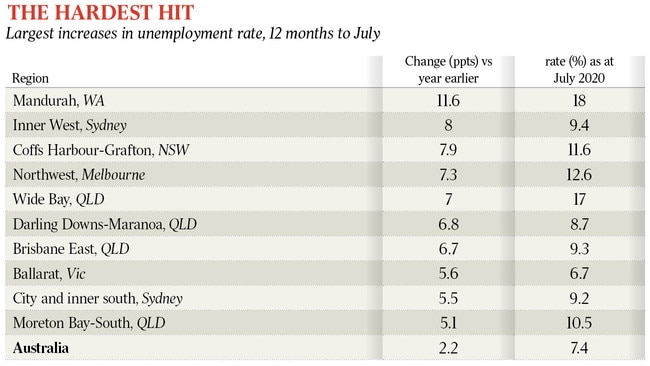Coronavirus: Regional workers hit by recession
Some regions have suffered much more severe lifts in unemployment than the country as a whole, new RBA research finds.

Mandurah in southwest Western Australia has suffered the biggest rise in unemployment in the country through the COVID-19 recession, analysis of data by The Australian reveals.
The statistical area south of Perth suffered a 12 percentage point increase in its jobless rate to 18 per cent over the year to July — the biggest hit among the 87 Australian regions included in the Australian Bureau of Statistics labour force data.
The next biggest lift in the jobless rate was found in Sydney’s inner west, where unemployment spiked to 9.4 per cent in July: eight percentage points higher than a year before.
As Scott Morrison on Friday announced that the national cabinet had tasked its rural and regional subcommittee with developing a plan to increase jobs outside the major cities, a new Reserve Bank of Australia research paper found regions that suffer the biggest blow to employment during recessions had “significantly higher unemployment rates for around a decade afterwards”.
While the focus has been on the national experience, the RBA report said a regional approach presented a more meaningful way of assessing the impact and potential long-lasting effects of a recession on workers.
The ABS figures showed the Coffs Harbour and Grafton statistical area in NSW, North West Melbourne and Wide Bay in Queensland rounded out the five hardest-hit regions.
The regional level data is in original terms, and so differs from the widely quoted national unemployment figures, which have been adjusted to account for seasonal factors. August numbers were not yet available.
The Prime Minister on Friday said the regional and rural subcommittee “will be working on the growth of jobs in rural and regional areas, and things that can be done to achieve that with the states and territories working together”.

The federal member for Wide Bay, Liberal MP Llew O’Brien, said his electorate, which covers some but not all of the statistical region of the same name, included towns with “really serious high unemployment and really serious youth unemployment”.
Mr O’Brien said his region, and regions like it, desperately needed investment in roads and electricity infrastructure to promote growth. Where the four-lane highway ended in Gympie was where the high unemployment started, he said.
“If you want to solve these economic and unemployment problems, then having the appropriate infrastructure is crucial,” Mr O’Brien said.
The RBA paper found that the early 1990s recession led to a range of employment outcomes, with the changes in regional jobless rates ranging between a drop of five percentage points to a jump of 13 percentage points.
“These differences in the ‘initial exposure’ of regions to national recessions can reflect differences in industry composition, demographics and average skill levels, among other factors,” the authors said.




To join the conversation, please log in. Don't have an account? Register
Join the conversation, you are commenting as Logout